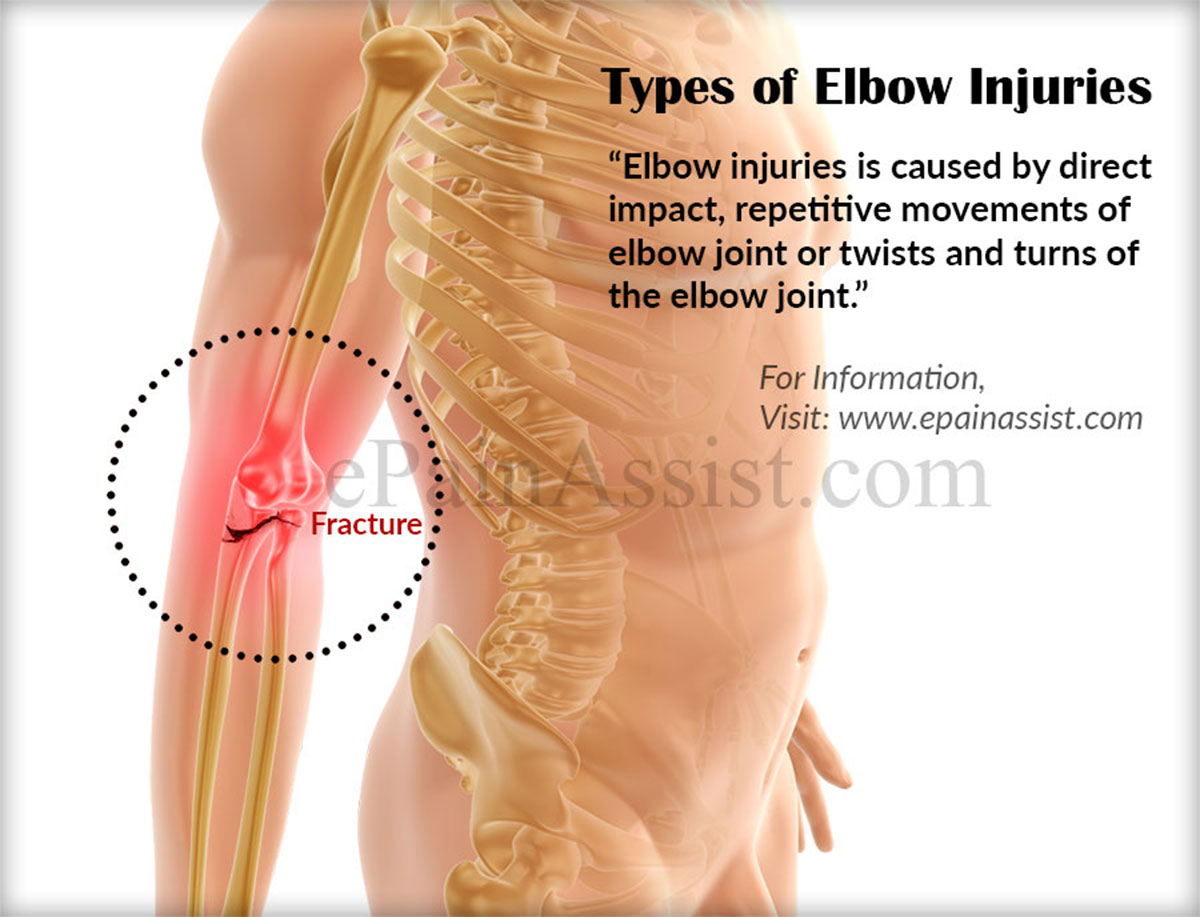Elbow joint is formed by ends of 3 long bones. The joint is formed by distal end of humerus, proximal end of radius and ulna.1 The ends of three elbow joint bones are covered by cartilage and synovial membrane. Elbow is supported by ligaments, tendons and muscles. Elbow is the second most important joint of upper arm after shoulder. Forearm bends and rotates at elbow. The elbow movement such as flexion and extension is a movement between forearm and upper arm to bring the hand close to mouth or shoulder joint. Elbow injuries restrict or reduce the elbow movement such as extension, flexion and rotation. Elbow injuries are often observed following automobile accident and sport injury. Elbow injuries occur when severe impact strikes outstretched arm during participation in contact sports, fall or automobile accident.

Elbow injuries is caused by direct impact, repetitive movements of elbow joint or twists and turns of the elbow joint. The direct impact on elbow joint is observed during injuries caused by contact sports, work accidents and automobile accidents. The fall on elbow joint can cause severe elbow trauma. The twist and turn of the elbow is observed in contact sports like wrestling and rugby. Individuals holding or using heavy equipment may twist upper extremity resulting in elbow injuries while trying to control sudden unexpected swing of the equipment. Impact transmitted through extended upper arm, which is stretched and extended, results in indirect violent collision of bones elbow joint.

Types of Elbow Injuries-
Elbow Fracture:
Elbow injuries resulting from fall, sports injury and automobile accidents often causes elbow fracture of one or more than one bones of elbow joint. Elbow fracture is caused by direct impact of elbow joint and rarely because of twist and turn of the upper extremity. Direct impact resulting in displaced and compound elbow fracture is often observed during sport, automobile and work injuries. Hairline elbow fracture is observed following low-grade impact or forceful twist of upper arm. Non-displaced elbow fracture may be seen when severe impact is transmitted through out stretched upper arm. The elbow injury is diagnosed with X-Ray, CT scan and MRI.2
The types of elbow fracture are as follows-
Hairline Elbow Fracture
Non-displaced Elbow Fracture
Displaced Elbow Fracture
Compound Elbow Fracture
Elbow Dislocation:-
Dislocated elbow is observed following fall or impact on outstretched arm. The elbow dislocation causes severe painful deformity. Elbow dislocation may or may not be associated with fracture of elbow joint. Laceration or tear of tendon and ligament is often associated with elbow dislocation. Dislocated elbow may be associated with joint bleeding resulting joint hematoma. The dislocation is diagnosed by X-Ray, CT scan or MRI and hematoma is diagnosed using ultrasound examination.

The types of elbow dislocation are as follows-
Partial Elbow Dislocation
Complete Elbow Dislocation
Tendon Injury of the Elbow:
Tendon injury of elbow is common following work injury. There are several tendon attached to elbow joint. The extensor, flexor and rotator muscle ends in bundle of tough fibrous tissue, which is attached to the elbow joint. The repetitive action and forceful twist and turn of elbow joint result in tendon injury of the elbow. Elbow tendon injury is diagnosed by clinical examination, soft tissue CT scan and MRI examination of tendons.
The types of tendon injuries of elbow are as follows-
Laceration and Inflammation of Tendon of the Elbow
Partial Tear of the Elbow Tendon
Complete Tear of Tendon
Hematoma:
Elbow injury causes bleeding within and outside elbow joint. The bleeding occurs from torn blood vessels. The collection of blood or blood clot outside joint is also known hematoma. The swelling caused by hematoma is soft and in few cases fluctuating during palpation examination. In few cases hematoma or blood clot get infected and results in abscess formation. Internal and external hematoma is diagnosed by CT scan and ultrasound.
Elbow Ligament Injury or Elbow Joint Sprain:-
Ligaments bind the end of bones together to form the joint. There are several ligaments that hold the bones and allow movements like flexion, extension and rotation. Ligaments fasten and adhere to the bones. Ligament tears causes severe pain with any movement of the joint and thus prevent joint movement. The ligament tear is often difficult to diagnose with radiological studies or ultrasound studies. The diagnosis is depends on findings of examination and radiological studies. Ligamental tear of the elbow is often associated with bleeding and hematoma formation within the elbow joint.
Laceration of Elbow Ligaments
Partial Tear of the Elbow ligament
Complete Tear of the Elbow Ligament
Laceration of Skin Spread Over Elbow:-
Direct impact and fall on elbow joint may cause skin laceration. Laceration of the skin spread over the elbow joint may or may not be associated with injuries of tendon, ligament and bones. Skin laceration over elbow causes pain and results in least complications. Skin laceration over elbows heals in 2 to 4 weeks. Laceration of skin is diagnosed by clinical examination and a radiological study does not show signs of dislocation or fracture. Laceration of skin over elbow may be associated with tendon or muscle injury or tear.
Elbow Joint Abscess-
Elbow joint abscess within the joint is a serious condition. Abscess is treated with intravenous antibiotics and surgery. Surgery involves incision and drainage of abscess. Patient often suffers with fever, weakness, lethargy and sweating. The blood examination shows increased white blood cell counts. The radiological studies like CT Scan and MRI shows fluid collection within or outside elbow joint. Ultrasound also shows fluid collection within or outside joint.
Also Read:

